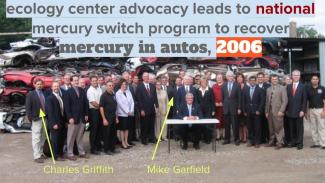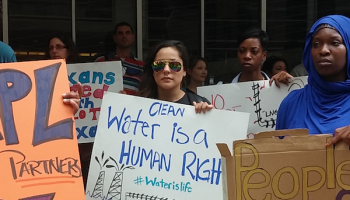By Yuki Nakayama, Ecology Center Environmental Storyteller Rackham Fellow
"We need materials and production systems in harmony with nature so that we are not constantly playing catch up to remove toxins in our environment." -Jeff Gearhart (Ecology Center Research Director)
The 20th anniversary of the National Vehicle Mercury Switch Recovery Program (NVMSRP) is coming up! Since the 1990s, the Ecology Center has been working on projects to address the use of toxic chemicals in consumer goods, including automobiles. After releasing its landmark 2001 study on mercury in automobiles, Ecology Center led the campaign to create this long-lasting, successful federal program. (more on EC's past articles on Healthy Cars here).

What Are Mercury-Containing Switches?
Mercury-containing switches are small glass capsules that contain about one gram of mercury (image below). They were used for decades to activate hood and truck convenience lights and as motion sensors for anti-lock braking systems. Non-mercury switch alternatives were always available for these applications, but were not commonly used in cars.
An Ecology Center-led campaign and legal pressure forced the auto industry to eliminate these switches in newly manufactured cars 20 years ago. However, this left millions of older vehicles with mercury switches that no one was taking responsibility for recovering.
What is the National Vehicle Mercury Switch Recovery Program (NVMSRP)?
NVMSRP is a voluntary nationwide agreement between the EPA, American Iron & Steel Institute, Automotive Recyclers Association, Ecology Center, Environmental Council of States, Environmental Defense, End of Life Vehicle Solutions, Institute of Scrap Recycling Industries, and the Steel Manufacturers Association to recover mercury switches from 2002 and older scrap vehicles before they are shredded for recycling. (Program establishment article from 2007)
They created a system and financial incentive by supplying prepaid collection buckets to be shipped to EPA warehouses. Participating automobile dismantlers are paid $1 per switch from a $4 million fund created by the industry. Mercury switches are small (roughly the size of an acorn), but each contains one gram or more of mercury.
Since 2006, over seven million mercury switches have been removed– the equivalent of roughly eight tons of mercury!

Why Should We Care?
Mercury is a dangerous neurotoxin that can cause serious health issues, such as developmental, neurological, behavioral, neuromuscular, cardiovascular, and immune system disorders. For example, inhaled as a vapor, mercury can cause tremors, memory loss, and muscle weakness. Mercury pollution threatens wildlife and can build up in the fish people eat. (more information on mercury and other toxins: Healthy Stuff Lab's Chemicals of Concern Article)
While Michigan banned mercury in thermometers in January 2002, it is still found in cars made in the 1980s and 1990s. Over 200 million mercury switches containing 250 tons of mercury were installed in vehicles before the project started in 2006. This means cars with mercury switches stayed on the road until they reached the end of their life cycle. Before this project, all car parts (including those with mercury) were shredded.
While coal-fired power plants are the #1 source of mercury pollution, emitting approximately 50 tons of mercury a year, car disposal was the third highest source of mercury emissions to the environment. As cars were disposed of, mercury pollution was released into our environment because a clean and safe system did not exist.
The NVMSRP is at the tail end of its project now that newer cars do not contain mercury switches. While not all of the mercury switches on the road were collected, the program successfully continued an important nationwide initiative for 20 years and created a large-scale project to address the disposal of products with toxic chemicals.
"A Product Design Disaster"
Jeff Gearhart, Ecology Center Research Director, described the issue as a “disaster in design,” stating that “They [manufacturers] weren’t thinking about the consequences or the lifetime of the products.” This led to the urgent need to develop a safe removal program to recover the millions of mercury switches out on the road.
The Ecology Center conducted survey reports exploring opportunities for public policy advocacy, market campaigns, and public exposure to ensure safe and healthy cars. The reports identified two key policy pieces: extended producer responsibility (to clean up the mess) and design responsibility, which clearly articulates the chemicals manufacturers cannot use (which sadly did not exist before the ’90s).
What is Extended Producer Responsibility?
Producer responsibility is about ensuring that manufacturers are held accountable through the entire life cycle of a product, not just its creation. This means requiring producers to bear the systemic and financial responsibility for the disposal process of the waste generated and addressing the environmental harm caused by their products.
In the case of mercury switches, the program started with the automobile and steel industry paying for prepaid buckets and collection payments. The initial incentive fund was exhausted in 2009, and the collection payments stopped, but the prepaid buckets continue to be provided through the program. Due to the automobile industry's reluctance to provide funding, the program was at risk of ending by 2017.
However, the steel industry decided to continue financially supporting the program, extending it through 2027 (press releases on program extension.)This is because Electric Arc Furnaces will face more regulations if they do not clean up mercury from steel scraps they process, creating an incentive for the industry to fund the mercury switch program. This highlights the challenge of ensuring the industry takes financial responsibility for using toxic chemicals in the absence of regulatory enforcement.
What is Design Responsibility?
Design responsibility is about getting to the source of the issue at the earliest stage possible in the production process. The NVMSRP successfully created a voluntary standard for the automobile industry to urge them to avoid specific chemicals in their products — a mixture of legal requirements, legislative efforts in individual countries, and voluntary efforts led by the industry. NVMSRP and many others have led to things like the Global Automotive Declarable Substance List, which requires suppliers to declare the use of certain chemicals and prohibits the use of the most toxic ones.
These efforts actively drive change in the supply chain so that toxic chemicals are not being used from the beginning rather than having to clean them up afterwards. It is important to note that many agreements are voluntary and not required, which is why we must continue to work to establish legislative requirements to hold the industry accountable for the products they design.
Lessons Learned from the Project
While the project removed over seven million switches (amounting to over seven million grams of mercury = eight tons) and limited mercury use in automobiles, there is still a long road ahead for clean and healthy cars.
Cars still have parts that contain PFAS, flame retardants, plastics, and other harmful chemicals, and the industry continues to face challenges in screening suppliers for hazards. For example, trifluoroacetic acid (TFA, a type of PFAS) is frequently used as a coolant in car air conditioners, even though safer alternatives, called "natural refrigerants," are available.
This means producer and design responsibility continues to be neglected as our cars are still produced using toxic and harmful materials. The same structural issues that the mercury switch recovery project faced are replicated across different toxic chemicals and industries.
Producer and design responsibility must be addressed in tandem to ensure that healthy products are created with imminent disposal in mind and to create a safe removal process for products already out in the world.
Alongside producer and design responsibility, the project identified other important principles that must be centered as we work towards a healthier world: better hazard assessments and green chemistry. There is an urgent need to develop better evaluation and screening tools built on an inherent hazard-based approach rather than waiting on long-term studies on individual chemicals. Some tools, such as Green Screen, help companies have better screening practices and alternatives at the design stage, but there is a need for more.
Better screenings also require more developments in green chemistry that can identify safer alternatives for manufacturers and consumers. However, a training gap is caused by the separation of scientific fields such as chemistry, environmental science, and toxicology, which are necessary for innovations in green chemistry. Funding for collaborative research across fields is urgently needed to expand our knowledge about materials.
Gearhart also stated, "We need materials and production systems in harmony with nature so that we are not constantly playing catch up to remove environmental toxins." Change is slow and gradual, but the mercury switch program shows us that it is never too late to act and that our collective effort is crucial to making big changes to ensure access to safe products.
What Can People Do?
-
Support extended producer laws in your state. Many states have bills regarding this key issue. In Michigan, House Bill 5902 was introduced in the House in 2024. Check out more information on the bill here.
-
Own fewer cars and use local public transportation. You can support local public and other fossil fuel-free forms of transportation projects. Check out programs like A2Zero, Adopt-a-stop, getDowntown, and D2A2 in Ann Arbor.
-
Support and advocate for urban city planning that relies on fewer cars and centers on more walking, biking, and public transit. Support local bills expanding public transportation, like MI House Bill 5769.
- Donate to the Ecology Center and stay informed about the ongoing campaigns at the Ecology Center on PFAS, Lead, and Microplastics. Start by learning about our Healthy Stuff Lab and our most recent article about the retailer report card.


